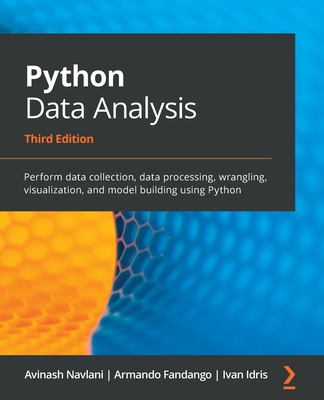Data Science Essentials in Python: Collect - Organize - Explore - Predict - Value
暫譯: Python 數據科學基礎:收集 - 組織 - 探索 - 預測 - 價值
Dmitry Zinoviev
- 出版商: Pragmatic Bookshelf
- 出版日期: 2016-09-13
- 售價: $1,050
- 貴賓價: 9.5 折 $998
- 語言: 英文
- 頁數: 226
- 裝訂: Paperback
- ISBN: 1680501844
- ISBN-13: 9781680501841
-
相關分類:
Python、程式語言、Data Science
-
相關翻譯:
Python數據科學入門 (Data Science Essentials in Python: Collect - Organize - Explore - Predict - Value) (簡中版)
立即出貨 (庫存 < 3)
買這商品的人也買了...
-
 大話設計模式
大話設計模式$620$527 -
 Python 程式設計入門 (適用於 2.x 與 3.x 版)
Python 程式設計入門 (適用於 2.x 與 3.x 版)$620$484 -
 Cisco CCNA Routing and Switching ICND2 200-101專業認證手冊 (Cisco CCNA Routing and Switching ICND2 200-101 Official Cert Guide)
Cisco CCNA Routing and Switching ICND2 200-101專業認證手冊 (Cisco CCNA Routing and Switching ICND2 200-101 Official Cert Guide)$800$680 -
 精通 Python|運用簡單的套件進行現代運算 (Introducing Python: Modern Computing in Simple Packages)
精通 Python|運用簡單的套件進行現代運算 (Introducing Python: Modern Computing in Simple Packages)$780$616 -
 Raspberry Pi 超炫專案與完全實戰, 2/e
Raspberry Pi 超炫專案與完全實戰, 2/e$580$493 -
 WordPress 架站的 12堂課|網域申請x架設x佈景主題x廣告申請
WordPress 架站的 12堂課|網域申請x架設x佈景主題x廣告申請$480$408 -
 $301軟技能代碼之外的生存指南 (Soft Skills : The software developer's life manual)
$301軟技能代碼之外的生存指南 (Soft Skills : The software developer's life manual) -
 Python 機器學習 (Python Machine Learning)
Python 機器學習 (Python Machine Learning)$580$452 -
 Windows 10 IOT 物聯網入門與實戰 - 使用 Raspberry Pi (附120段教學與執行影片/範例檔)
Windows 10 IOT 物聯網入門與實戰 - 使用 Raspberry Pi (附120段教學與執行影片/範例檔)$580$493 -
 網站擷取|使用 Python (Web Scraping with Python: Collecting Data from the Modern Web)
網站擷取|使用 Python (Web Scraping with Python: Collecting Data from the Modern Web)$580$458 -
 iOS 10 App 程式設計實力超進化實戰攻略 : 知名 iOS教學部落格 AppCoda 作家親授實作關鍵技巧讓你不NG
iOS 10 App 程式設計實力超進化實戰攻略 : 知名 iOS教學部落格 AppCoda 作家親授實作關鍵技巧讓你不NG$720$562 -
 今天不學機器學習,明天就被機器取代:從 Python 入手+演算法
今天不學機器學習,明天就被機器取代:從 Python 入手+演算法$590$502 -
 高效率資料分析|使用 Python (Foundations for Analytics with Python)
高效率資料分析|使用 Python (Foundations for Analytics with Python)$580$458 -
 前端&行動網頁設計速成班-Bootstrap 4 + CSS3 + HTML5 + JavaScript
前端&行動網頁設計速成班-Bootstrap 4 + CSS3 + HTML5 + JavaScript$520$411 -
 Git 團隊使用手冊 (Git for Teams: A User-Centered Approach to Creating Efficient Workflows in Git)
Git 團隊使用手冊 (Git for Teams: A User-Centered Approach to Creating Efficient Workflows in Git)$580$458 -
 Python 自動化的樂趣|搞定重複瑣碎 & 單調無聊的工作 (中文版) (Automate the Boring Stuff with Python: Practical Programming for Total Beginners)
Python 自動化的樂趣|搞定重複瑣碎 & 單調無聊的工作 (中文版) (Automate the Boring Stuff with Python: Practical Programming for Total Beginners)$500$425 -
 React 啟動與運行 (React: Up & Running: Building Web Applications)
React 啟動與運行 (React: Up & Running: Building Web Applications)$580$458 -
深度學習快速入門 — 使用 TensorFlow (Getting started with TensorFlow)
$360$180 -
 演算法技術手冊, 2/e (Algorithms in a Nutshell: A Practical Guide, 2/e)
演算法技術手冊, 2/e (Algorithms in a Nutshell: A Practical Guide, 2/e)$580$458 -
![Google [G Suite] for Education上課趣-文件、試算表、簡報、雲端教室完全活用-cover](https://cf-assets1.tenlong.com.tw/images/115287/medium/9789864341870.jpg) Google [G Suite] for Education上課趣-文件、試算表、簡報、雲端教室完全活用
Google [G Suite] for Education上課趣-文件、試算表、簡報、雲端教室完全活用$360$281 -
 JavaScript & JQuery : 網站互動設計程式進化之道 (JavaScript and JQuery: Interactive Front-End Web Development)
JavaScript & JQuery : 網站互動設計程式進化之道 (JavaScript and JQuery: Interactive Front-End Web Development)$780$663 -
 機器博士帶你輕鬆看懂網路技術
機器博士帶你輕鬆看懂網路技術$320$272 -
 Android 雲端與物聯網關鍵通訊技術
Android 雲端與物聯網關鍵通訊技術$520$411 -
 七天學會設計模式:設計模式也可以這樣學
七天學會設計模式:設計模式也可以這樣學$320$250 -
 Big Data Analysis with Python (Paperback)
Big Data Analysis with Python (Paperback)$1,270$1,207
相關主題
商品描述
Go from messy, unstructured artifacts stored in SQL and NoSQL databases to a neat, well-organized dataset with this quick reference for the busy data scientist. Understand text mining, machine learning, and network analysis; process numeric data with the NumPy and Pandas modules; describe and analyze data using statistical and network-theoretical methods; and see actual examples of data analysis at work. This one-stop solution covers the essential data science you need in Python.
Data science is one of the fastest-growing disciplines in terms of academic research, student enrollment, and employment. Python, with its flexibility and scalability, is quickly overtaking the R language for data-scientific projects. Keep Python data-science concepts at your fingertips with this modular, quick reference to the tools used to acquire, clean, analyze, and store data.
This one-stop solution covers essential Python, databases, network analysis, natural language processing, elements of machine learning, and visualization. Access structured and unstructured text and numeric data from local files, databases, and the Internet. Arrange, rearrange, and clean the data. Work with relational and non-relational databases, data visualization, and simple predictive analysis (regressions, clustering, and decision trees). See how typical data analysis problems are handled. And try your hand at your own solutions to a variety of medium-scale projects that are fun to work on and look good on your resume.
Keep this handy quick guide at your side whether you're a student, an entry-level data science professional converting from R to Python, or a seasoned Python developer who doesn't want to memorize every function and option.
What You Need:
You need a decent distribution of Python 3.3 or above that includes at least NLTK, Pandas, NumPy, Matplotlib, Networkx, SciKit-Learn, and BeautifulSoup. A great distribution that meets the requirements is Anaconda, available for free from www.continuum.io. If you plan to set up your own database servers, you also need MySQL (www.mysql.com) and MongoDB (www.mongodb.com). Both packages are free and run on Windows, Linux, and Mac OS.
商品描述(中文翻譯)
從儲存在 SQL 和 NoSQL 資料庫中的雜亂無章、無結構的資料,轉變為整齊、組織良好的資料集,這本快速參考手冊專為忙碌的資料科學家而設。了解文本挖掘、機器學習和網路分析;使用 NumPy 和 Pandas 模組處理數值資料;使用統計和網路理論方法描述和分析資料;並查看實際的資料分析範例。這個一站式解決方案涵蓋了您在 Python 中所需的基本資料科學知識。
資料科學是學術研究、學生註冊和就業中增長最快的學科之一。Python 以其靈活性和可擴展性,迅速超越 R 語言,成為資料科學專案的首選。透過這本模組化的快速參考手冊,隨時掌握 Python 資料科學的概念,了解用於獲取、清理、分析和儲存資料的工具。
這個一站式解決方案涵蓋了基本的 Python、資料庫、網路分析、自然語言處理、機器學習的要素以及視覺化。從本地檔案、資料庫和互聯網訪問結構化和非結構化的文本和數值資料。整理、重新排列和清理資料。處理關聯和非關聯資料庫、資料視覺化以及簡單的預測分析(回歸、聚類和決策樹)。了解典型的資料分析問題是如何處理的。並嘗試自己解決各種中型專案,這些專案既有趣又能增添您的履歷。
無論您是學生、從 R 轉向 Python 的初級資料科學專業人士,還是希望不必記住每個函數和選項的資深 Python 開發者,都可以隨時攜帶這本方便的快速指南。
您需要的:
您需要一個合適的 Python 3.3 或以上版本的發行版,至少包含 NLTK、Pandas、NumPy、Matplotlib、Networkx、SciKit-Learn 和 BeautifulSoup。滿足這些要求的優秀發行版是 Anaconda,您可以從 www.continuum.io 免費獲得。如果您計劃設置自己的資料庫伺服器,還需要 MySQL (www.mysql.com) 和 MongoDB (www.mongodb.com)。這兩個套件都是免費的,並且可以在 Windows、Linux 和 Mac OS 上運行。














